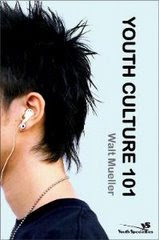 Click here to learn more about Introducing Moral Theology: True Happiness and the Virtues by William C. Mattison III.
Click here to learn more about Introducing Moral Theology: True Happiness and the Virtues by William C. Mattison III.William Mattison (WM) is assistant professor of theology at The Catholic University of America.
CPYU: What motivated you to write your new book Introducing Moral Theology: True Happiness and the Virtues? And who is the intended audience?
WM: The book is basically a written version of an Introduction to Christian ethics course I have now taught over 20 times the past six years at four different institutions. When I began teaching there seemed to me a real need for an accessible, engaging presentation of Christian discipleship as an alluring and persuasive answer to the basic human question, “How can I live a happy life?” University students today are for the most part poorly formed in matters of faith, and their ideas of what Christianity entails too often consist of childish imagery or mere moral maxims. In the tradition of great books like C.S. Lewis’ Mere Christianity, and excellent recent books like Lee Camp’s Mere Discipleship, I hoped to present an accessible and engaging yet thoroughgoing account of the Christian answer to the question, “How can I live a good, i.e., happy, life?”
CPYU: Briefly describe what you mean by “true happiness.” How might your definition conflict with popular cultural notions of “happiness”?
WM: For centuries from classical thinkers such as Aristotle through Christian greats such as Augustine and Aquinas, morality was simply understood as the path to a genuinely happy life. True fulfillment, or happiness, was constituted by living virtuously. Now we too often understand morality or virtue as an impediment to our happiness. That is sad. The book tries to make the case that the questions “How can I live a morally good life?” and “How can I be truly happy?” are one and the same.
As evidenced by the important differences among the thinkers mentioned above, establishing that morality is about happiness is a distinct matter from explaining what true happiness is! Yet notwithstanding important differences among these thinkers, they are all representative of one of two basic answers to the question of human happiness. They all recognize that happiness is essentially a matter of friendship, of communal living for the common good (of our friends, our families, our cities, etc.). This is opposed to the rival understanding of happiness, so popular today, as self-centered and individualistic, in short, as getting whatever one wants. True happiness is instead about wanting what is truly best for ourselves and for those with whom we share life.
Of course, Christians have a distinctive take on the nature of that friendship. It is friendship with God, a very participation in the Triune divine life made possible by Jesus Christ, who calls us His friends and invites us to a life in communion with God and others where our joy is complete. Christian discipleship is answer to, not a rejection of, the human longing for happiness. Indeed, though it answers that natural longing it does so in a way that far transcends anything that humanity could understand let alone live out without God’s grace.
CPYU: There is a recent movement of college presidents seeking to lower the drinking age. This has sparked a national conversation about binge drinking in college. As a professor of moral theology, what do you think are some of the deeper issues related to drinking on today’s college campuses?
WM: One of the biggest problems with the approach toward students on college campuses today is the near complete adoption of a morality of obligation rather than a morality of happiness. Students are presented with rules that are backed by fear of consequences of some sort. What we need to lead students to question is how their drinking is contributing to (or, at least as likely, impeding) their ability to live genuine happy and fulfilling lives. The goal is not to “not drink,” but to live well. To the extent that drinking alcohol contributes to that endeavor, fine. But it takes only a modicum of reflection with college students to lead them to see how common practices concerning alcohol on college campuses today actually impede the very things students claim to be pursuing when they drink: deepened friendship, relaxation, romantic relationships, etc.
CPYU: In your book there is a chapter entitled “Alcohol and American College Life: Test Case One.” What did you learn from writing that chapter that might inform this conversation?
WM: First of all, there are a lot more students in college who do not abuse alcohol than we might expect. It seems we would go far by lifting these students up. By fixating on those who abuse alcohol we unwittingly reinforce a drinking culture at college.
Second, we concentrate disproportionately on the external effects of drinking: drop out rates, drunk driving, vandalism, violence (including sexual violence), etc. These are serious problems to be sure and we ignore them at our peril. But by concentrating solely on these more obviously measurable problems resulting from problematic alcohol use, “solutions” often take the form of designated drivers, drinking near to home, staying close to friends to keep an eye on us, etc. Elaborate student practices have developed to enable people to keep drinking excessively and yet not face these bad effects. But that fails to address how our (ab)use of alcohol can warp our characters, displace other more genuine goods in our lives, and corrupt the friendships and romantic relationships that we engage in while relying on alcohol for relaxation and socialization. In short, the more obvious negative side effects of drinking are not the only problem with alcohol at college today.
Third, an honest and detailed look at why and how we drink reveals much about where we hold alcohol in terms of our priorities, and how it stands up to other priorities we insist are more important to us than drinking but which appear on closer examination to be governed by and deformed by our drinking practices.
CPYU: Many of our readers, parents and youth workers, are preparing students for college. What do you think are some of the challenges students face transitioning to college and how can we begin to nurture virtues in our teens that will help them navigate those challenges?
WM: So many freshman who arrive on college campuses find themselves free of the rules that had prevented them from drinking alcohol, and as a result drink excessively in reaction against the yoke of those perceived taboos. To the extent that we parents and educators present the rules regarding drinking as obligations, as barriers to living well rather than aids to living more genuinely fulfilling lives (quite possibly including the drinking of alcohol), we fail to prepare young adults to see on their own the rationale behind our rules and choose for themselves responsible behavior that is not simply “the right thing to do” but actually a more rewarded and fulfilling way to live.
Related Links:
Click here to read an excerpt of Introducing Moral Theology
Derek Melleby's thoughts in USA Today on lowering the drinking age
























